Tsuruga Head OfficeIn the Fast Breeder Reactor Research and Development Center,“MONJU”, the following procedures were completed: modification work as a measure against sodium leakage; an entire system function test to check the overall functioning of the plant including the modified parts (excluding the water/ steam system); preparation and inspection for the System Start-up Test (SST) to confirm the condition of the valves and switches before starting plant operations; and an earthquake-proofing safety assessment related to the Niigata Chuetsu-Oki Earthquake. After that, the “MONJU” SST was restarted on May 6, 2010 for the first time in 14 years and 5 months, and it reached criticality on May 8; furthermore, the core confirmation test, which is the first step in the 3 step-SST that will be conducted for 3 years, was completed on July 22, 2010. The Applied Laser Technology Institute was established in September 2009, with the aim of contributing to industries in Fukui Prefecture with laser technology. The “FUGEN” decommissioning project has been progressing steadily, and an aging research laboratory has been provided in coordination and cooperation with the Kansai Electric Power Co., Inc.
|
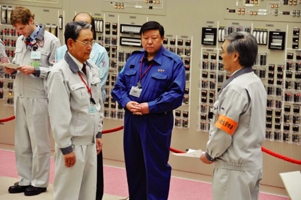 The Director General of “MONJU”, Mr. Mukai, reporting the SST restart to then-president Mr. Okazaki on May 6, 2010.
Opening ceremony of the Applied Laser Technology Institute, held on September 29, 2009. |
Tokai Research and Development Center, Nuclear Science Research Institute (NSRI)Research reactors (JRR-3, JRR-4, NSRR), accelerators, critical experiment facilities (STACY, FCA, etc.), and research facilities (WASTEF, BECKY, etc.) in which nuclear fuel can be treated are safely and successfully operated at the NSRI. In addition, cold facilities such as the LSTF and Large Scale Reflood Test Laboratory are in operation for studies of thermal-hydraulic phenomena. These facilities have been actively utilized in various research and development activities by researchers mainly from JAEA’s Nuclear Science and Engineering Directorate, Nuclear Safety Research Center, Quantum Beam Science Directorate, and Advanced Science Research Center. NSRI personnel are carrying out developments to realize JRR-3’s high-intensity cold neutron beam, and are developing neutron calibration technology for neutron dosimetry. Moreover, techniques to measure the void fraction in two-phase flow under high temperature and high pressure have been successfully developed, in order to investigate the behavior of two-phase flow under conditions simulating nuclear reactors (Topic 14-2).
|
Facilities in the Nuclear Science Research Institute to facilitate and support the utilization of nuclear energy and quantum beamsOther research facilities in the NSRI: JRR-4, Fast Critical Assembly (FCA), Waste Safety Testing Facility (WASTEF), Tandem Accelerator, Facility of Radiation Standards (FRS), etc.
Large-scale cold facilities to investigate thermal-hydraulic phenomena in nuclear reactors
|
Tokai Research and Development Center, Nuclear Fuel Cycle Engineering LaboratoriesAt the Plutonium Fuel Development Center, an engineering-scale test is being carried out to develop a fuel fabrication technology named the simplified MOX pellet fabrication process. Last year, 18 fuel assemblies that were fabricated using pellets obtained from the test were supplied to “MONJU” for its plant performance test. Moreover, a pressing machine with a die-wall lubrication system was installed to develop the process. Seismic reinforcement of the Tokai Reprocessing Plant is being carried out at the Reprocessing Technology Development Center. Various other R&D activities are being executed, such as advanced reprocessing using an aqueous method and geological disposal technologies. Additionally, construction of an incineration facility for radioactive waste treatment is currently under planning. |
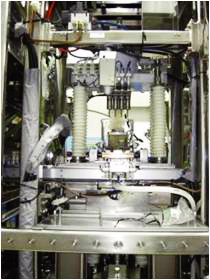 Die-wall lubrication system for engineering-scale test |
J-PARC CenterAll experimental facilities of the Japan Proton Accelerator Research Complex (J-PARC) have been available for user programs since the first neutrino beam was successfully produced in April 2009. For the second user program year of the Materials and Life Science Experimental Facility (MLF), 111 proposals, for the eight neutron instruments and one muon instrument, were approved in the general use category through a call for proposals and proposal review. After the proton beam intensity was ramped up to 120 kW in November 2009, a remarkable high beam availability of 86 to 92% was achieved. Currently, the J-PARC accelerators are stably providing users with beams higher than 100 kW after accomplishing the mid-term objective of a beam operation with a power of 100 kW in 2008. Moreover, in December 2009, a 300 kW proton beam was successfully accelerated and delivered to the MLF, producing the world’s highest intensity neutron and muon beams at that point in time. |
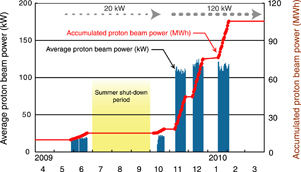 This Picture(174KB) Proton beam power delivered to a pulsed spallation neutron source at the Materials and Life Science Experimental Facility in J-PARC, in FY2009 |
Oarai Research and Development CenterExperiments needed in the Fast Reactor Cycle Technology Development (FaCT) Project were conducted: post-irradiation examination of FBR high burn-up fuel, minor actinide containing fuel, and sodium tests. Construction began for the Advanced Technology Experimental Sodium (Na) facility (AtheNa) for coolant system equipment for the demonstration plant. The Japan Materials Testing Reactor (JMTR) proceeded with refurbishment work for restart in FY2011. The 2nd International Symposium on Material Testing Reactors was held, in Idaho, U.S.A., including the Idaho National Lab, for information exchange and discussions related to technology implementation. The statutory report (final report) of the results of investigating the case in which there was an obstacle on the in-vessel storage rack in the experimental fast reactor “JOYO” (which occurred in November 2007) was submitted to MEXT, and detailed design work was conducted relating to replacement equipment for the upper core structure (Topic 14-8). The High Temperature engineering Test Reactor (HTTR) reached 50 days of full power operation with a 950 °C outlet coolant temperature, and obtained data on the characteristics of high-temperature equipment, for basic technology establishment and demonstration.
|
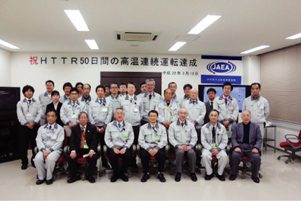 HTTR reached 50 days of full power operation |
Naka Fusion InstituteThe Naka Fusion Institute, together with the Fusion R&D Directorate, is working toward the utilization of fusion energy. As well as fusion plasma research and fusion engineering research, equipment production is advancing, in our capacity as a domestic agency of the experimental reactor ITER, which will be constructed in France. The Satellite Tokamak JT-60SA Program is being developed as a part of the Broader Approach activities, in cooperation with the EU, for the purpose of supporting and complementing ITER. In 2009, the first production of a superconducting conductor for the JT-60SA coil was successful, and two conductors were completed. Moreover, the preparation work for dismantling JT-60 proceeded, and a special area for safely keeping removed activated matter in solid containers was prepared on the premises. Storage-keeping began, and the high voltage table of the heating device and the radiation shielding wall were transferred to storage for reutilization in JT-60SA.
|
Inside the experimental building, where the space to carry out work on the main body of JT-60 was secured after preliminary dismantling work progressed (upper) |
Takasaki Advanced Radiation Research InstituteTakasaki Ion Accelerators for Advanced Radiation Application (TIARA), which consists of four ion accelerators, an electron accelerator, and gamma irradiation facilities at the JAEA’s Takasaki Advanced Radiation Research Institute, are open to researchers in JAEA and other organizations to perform R&D on new-functional and environmentally-friendly materials, biotechnology, the radiation effects of materials, and quantum beam analysis. Practical technology development activities are in progress relating to microbeams, single ion hits, and uniform wide-area irradiation techniques at the cyclotron, and three-dimensional in-air PIXE analysis and three-dimensional microbeam writing technology with different energy proton beams at the electrostatic accelerators. In 2009, a technique for quickly changing the ion species of heavy-ion microbeams at 1μm size in 30 minutes was developed by a combination of cocktail-beam and flat-top acceleration technologies at the AVF cyclotron (Topic 14-10). |
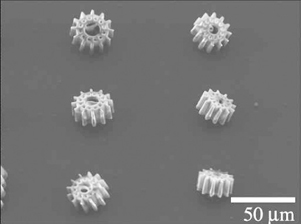 Three-dimensional fine structure organic material parts were fabricated using scanning irradiation of proton microbeams having energies of 1 and 3 MV, and subsequent chemical etching |
Kansai Photon Science InstituteAt our facility in the Kizu district outside Osaka, we are making improvements in advanced lasers, such as improved beam quality for high-energy lasers and increased X-ray laser repetition rates. Moreover, the Photo-Medical Research Center is promoting the creation of a “Photo-Medical Valley” (Chapter 5) funded by the Special Coordination Fund for Promoting Science and Technology commissioned by the Ministry of Education, Culture, Sports, Science and Technology. In addition, the Consortium for Photon Science and Technology (C-PhoST) is developing high-Quality Ultra-Advanced Radiation sources (QUADRA) as a core institute. In the Harima district, we are developing state of the art measurement techniques and equipments for materials science using intense X-rays at four JAEA beamlines in SPring-8, the world’s largest synchrotron radiation facility. In addition, we are promoting the application of these techniques to specific researches in material, energy and environment using JAEA beamlines. Some of these researches are related to actinide science, and important in nuclear energy development. |
 JAEA Kansai Advanced Relativistic ENgineering (J-KAREN) laser system |
Horonobe Underground Research CenterThe Horonobe Underground Research Laboratory Project is a project utilizing research facilities deep underground and is carrying out geological disposal research and development focusing on sedimentary rock. In FY2009, the ventilation shaft and the east access shaft were excavated to depths of 250 m and 225 m, respectively. The construction of the 140 m drift was completed by excavating from the east access shaft to the ventilation shaft in May, and by excavating to the west access shaft (before construction) in September. The International Communication House was opened in October 2009, as a place for information exchange/communication for domestic/overseas researchers and local residents, and for supporting events such as lecture meetings and debriefing sessions. In the next fiscal year, excavation of the east access shaft to a depth of 250 m and additional tunneling at 250 m (from the east access shaft to the ventilation shaft) will be carried out. In addition, investigations on how to control the inflow of groundwater into the underground facilities and construction of countermeasures will continue to be carried out.
|
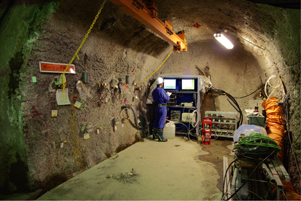 In-situ tests carried out in the 140 m gallery of the Horonobe URL |
Tono Geoscience Center (TGC)The TGC’s task is to provide the scientific and technical basis for safe geological disposal of high-level radioactive waste. This involves research on long-term stability of the geological environment, and researches on development and improvement of techniques for characterization of the deep geological environment and a wide range of engineering for deep underground application at an underground research laboratory in crystalline rock, referred to as Mizunami Underground Research Laboratory (MIU). As of March 2010, the Main and Ventilation Shafts had reached GL -459.6 m and -459.8 m (meters below ground level). Research and development activities were conducted, such as geological mapping during excavation and borehole investigations at the -300 m Stage (Topic 14-11).
|
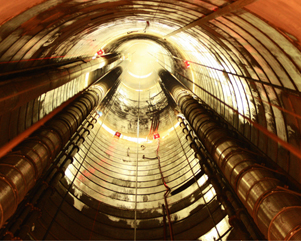 View up inside the Main Shaft from GL -400 m |
Ningyo-toge Environmental Engineering CenterWe are working on engineering development for the decommissioning of the uranium conversion plant (URCP) facility and uranium enrichment plant facility in the Ningyo-Toge Environmental Engineering Center. We began the decommissioning project in the URCP facility in FY2008. The URCP facility is a commercial-scale nuclear fuel facility, and the project of decommissioning the URCP facility is the first such trial for a commercial-scale nuclear fuel facility in Japan. Therefore, it is important to collect and evaluate information on the results of the decommissioning work, because the results of the URCP facility decommissioning project will be reflected in future similar decommissioning projects. The main information collected is the number of workers, the content of the work, and the work procedures. In addition, we conduct investigations into the material and weight of dismantled equipment. The URCP facility has 37 rooms in its radiation controlled area, and we completed dismantling 14 rooms in FY2009 that were begun in FY2008. The gross weight of dismantled equipment is about 300 t. This is equivalent to about 60% of the equipment weight in the radiation controlled area of the URCP facility. We will continue to develop the engineering for dismantling at this commercial-scale nuclear fuel facility, and we will also continue to collect/evaluate information about the results of the decommissioning work.
|
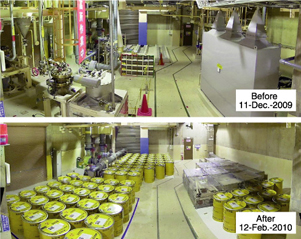 This Picture(246KB) This photograph shows the states before and after dismantling in the hydration and conversion room (3rd floor). The equipment for the hydration preprocessing process and the dehydration reduction process, which made up the conversion process, were installed in the hydration and conversion room. We carried out the dismantling/removal of the utility equipment in this room in FY2008. The dismantling/removal of the processing equipment concluded in FY 2009. |
Aomori Research and Development CenterIn the Rokkasho district in Aomori Prefecture, all of the main buildings for the International Fusion Energy Research Centre were opened this March for the beginning of full-scale activities relating to the “Agreement for the Joint Implementation of the Broader Approach (BA) in the Field of Fusion Energy Research” between the government of Japan and the European Atomic Energy Community. In the Mutsu district of Aomori, a research survey for reasonable/economical large assembly dismantling methodology for the operation of a waste disposal plant for research facilities, etc. has been carried out, and a clearance evaluation system database is being compiled. Such a practical decommissioning method is under progress for decommissioning the reactor facility of the nuclear-powered ship Mutsu. Also, the development of a technology to analyze ultra trace elements using accelerator mass spectrometry (AMS) is continuing, while the AMS has been opened for public use. Exchange of information between users was carried out by the hosting of the second AMS user's briefing session.
|
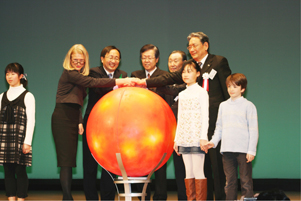 Photo at the ceremony to commemorate the completion of the International Fusion Energy Research Centre facilities |